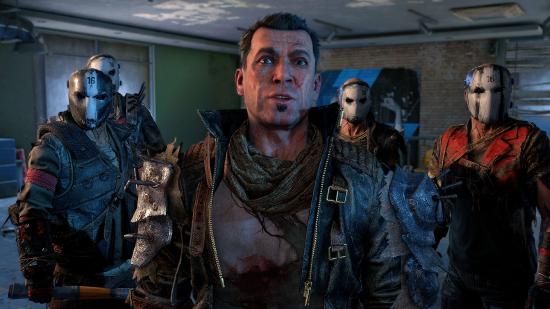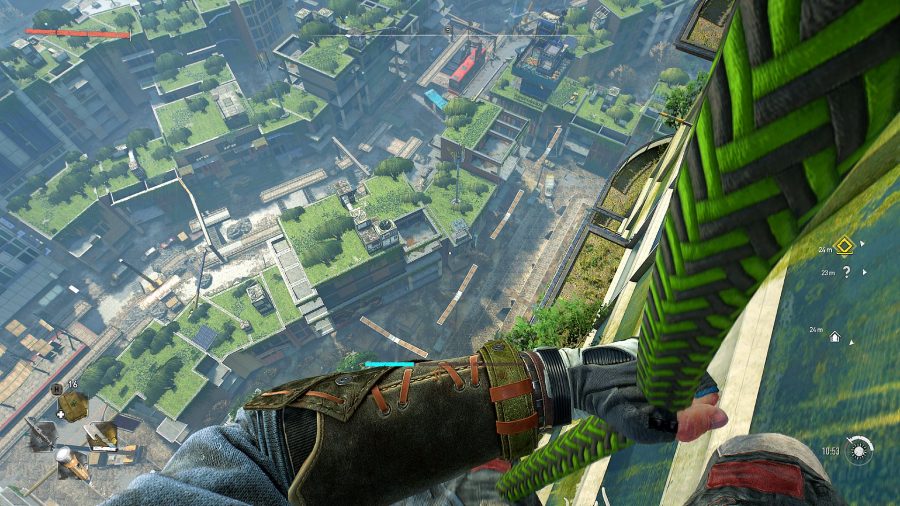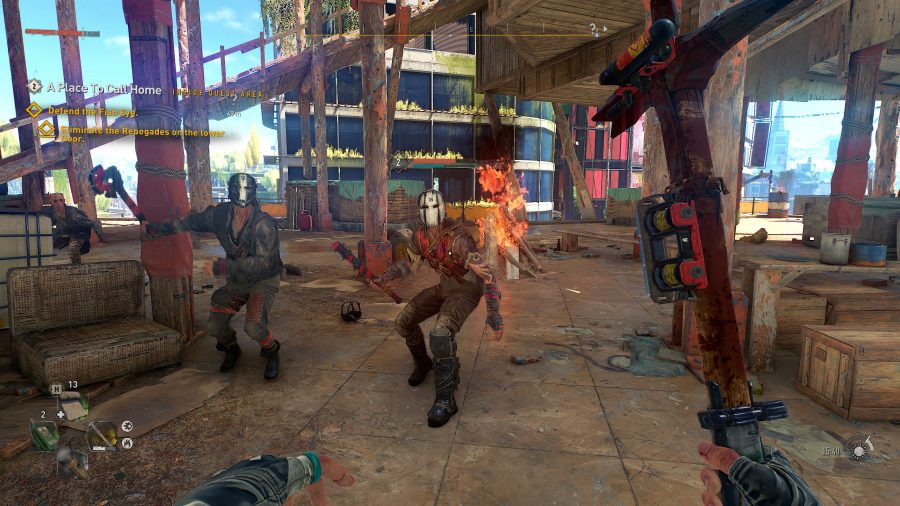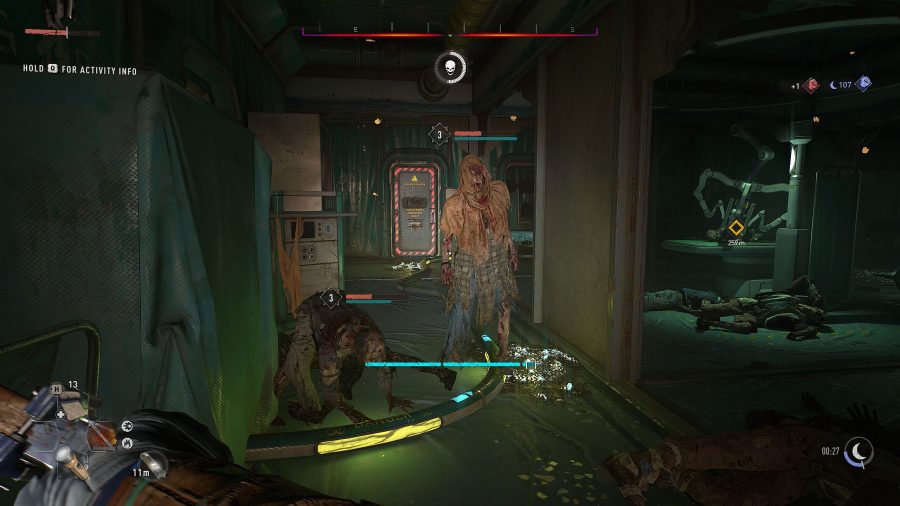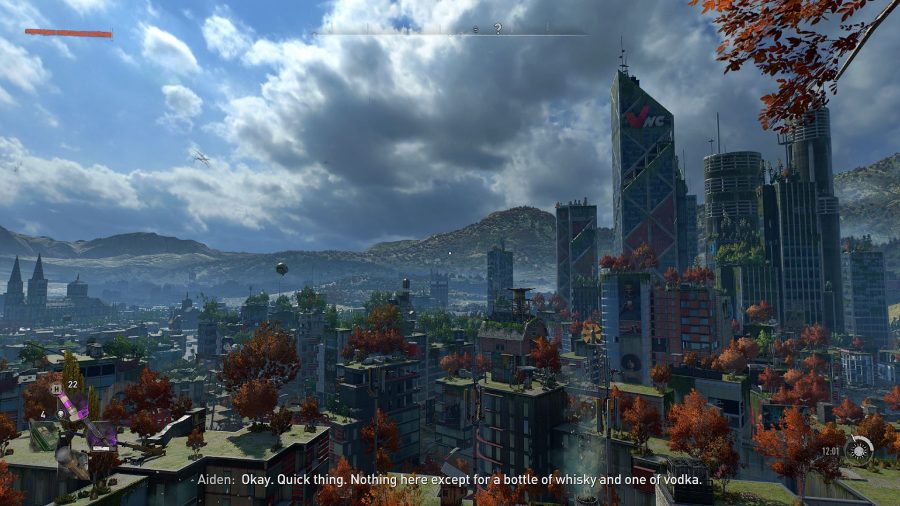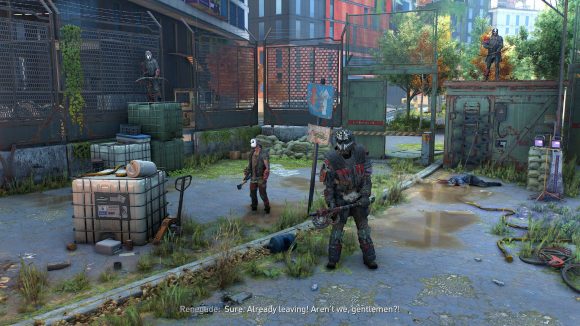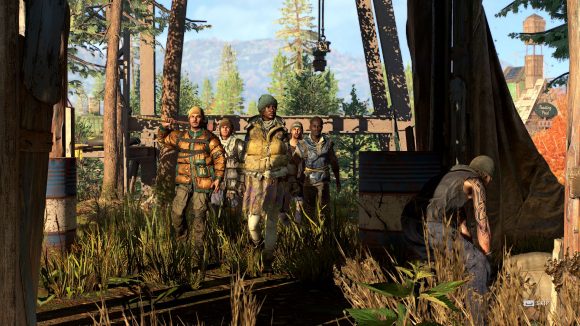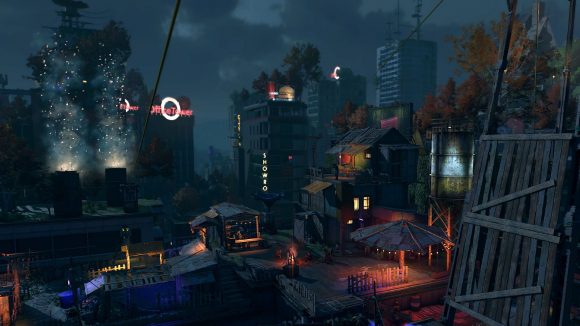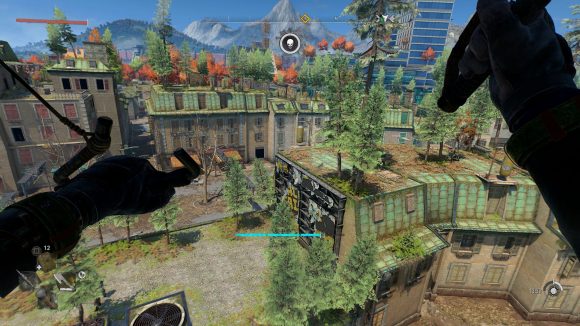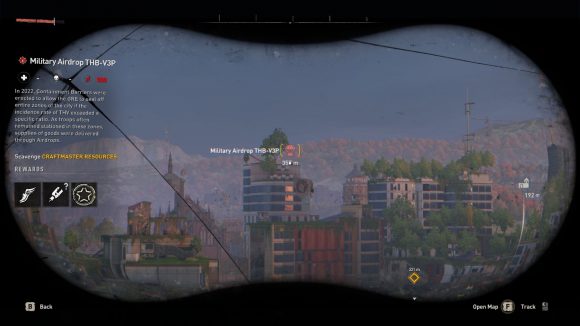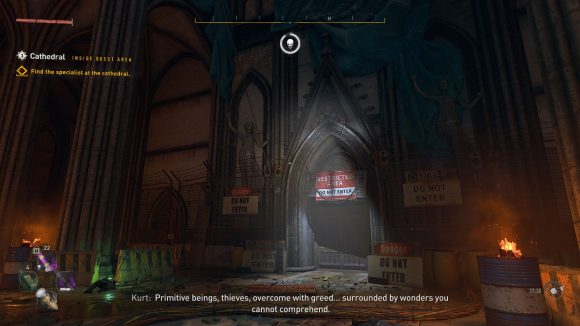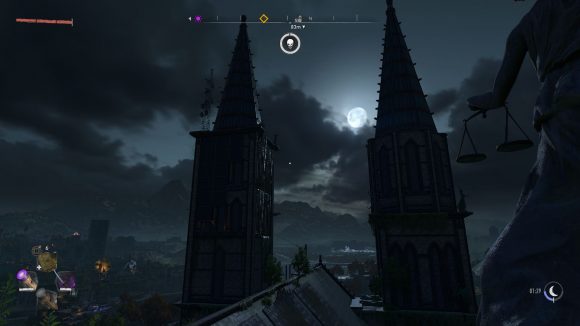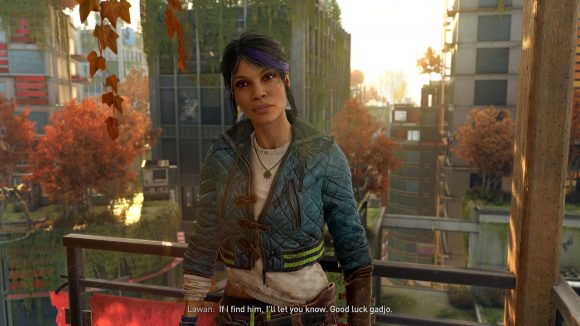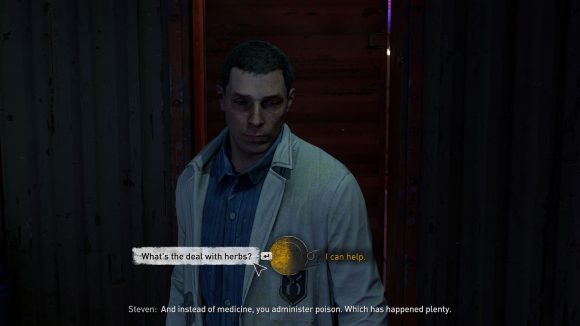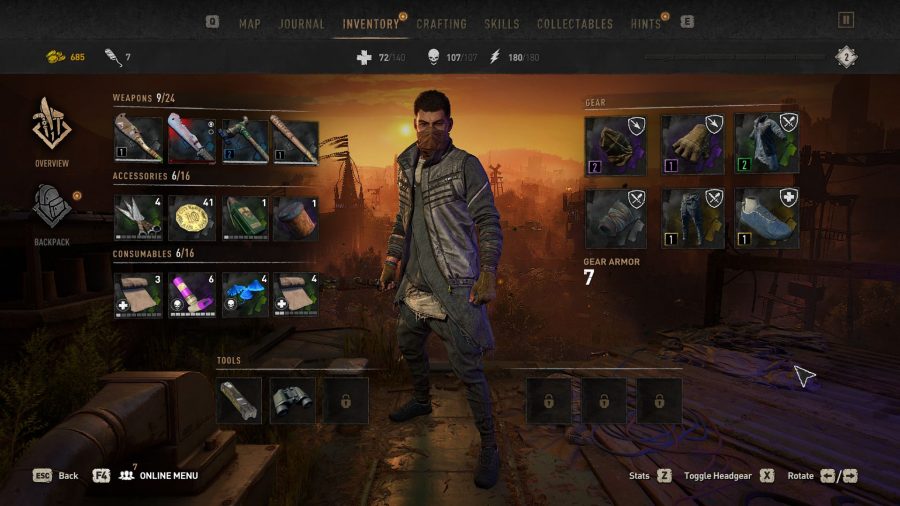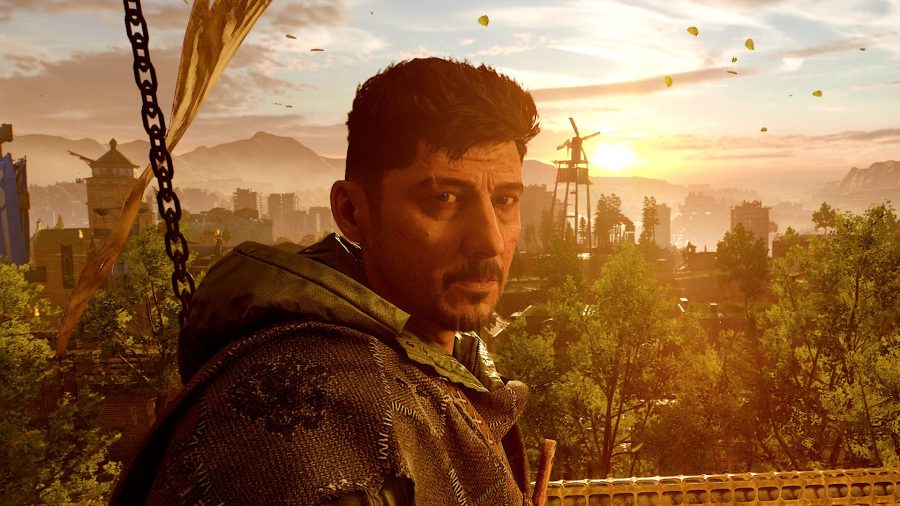Our Verdict
Bugs, repetitive side content, bad storytelling, and the unfulfilled promise of its choice and consequence system leave Dying Light 2 unable to capitalise on the strength of its excellent parkour and combat mechanics.
Dying Light 2 makes a bad first impression and an even worse one in closing. There are moments of genuine joy in its robust parkour system and chunky melee combat, but those moments are stretched thin across hours of lacklustre storytelling and repetitive side content. It’s a game that promises consequences for every choice you make, but the payoff often feels so thin as to remind you of Fallout 3’s infamous slideshow ending.
You play as Aiden Caldwell, a wanderer who’s searching for his missing sister in the last standing city after a zombie apocalypse. As with the original Dying Light, you make your way through the streets and rooftops with an array of parkour moves, and fight off both living and undead enemies with a selection of improvised melee tools.
It takes some time getting to grips with the parkour system, and the early hours of the Dying Light 2 – which you can buy here, coincidentally – will see you getting caught on world geometry and running up walls you didn’t mean to. It’s a shame that failure feels like the game breaking rather than a consequence of your actions, but those moments of frustration become much less frequent as you come to understand the mechanics and the flow of freerunning.
When the parkour clicks, it’s an absolute delight. The rooftops all seem to be spaced so that every leap leaves you just fingertips away from your destination before your hand shoots out, grabs the ledge, and pulls you into the next leg of your sprint. It’s satisfying, and the game keeps introducing significant new options throughout its runtime, like a grappling hook and paraglider, which keep the platforming fresh. Buildings also get increasingly tall as you move deeper through the story and into the city, making those climbs increasingly nerve-wracking as your goals reach higher into the clouds.
The feel of melee combat is robust and gratifying, too. Enemy heads shoot off their shoulders with a slow-mo ‘pop’ when you score a critical hit, and as gruesome as it is, bludgeoning bad guys with pipes and watching them get knocked back, double over in pain, and collapse to the ground stays fun for a long time.
It doesn’t stay fun forever, though. While the core of melee combat – run in, strike, and get out of range before the enemy can react – is great, there’s not enough variety to keep it engaging for the long haul. There are three types of human enemies that you’ll face for the majority of the game: bog-standard melee grunts, archers, and big, slow bruisers with giant makeshift weapons. I quickly settle into a repetitive sequence anytime a fight breaks out: run around the arena killing the ranged enemies, then pick off the smaller melee enemies one by one, and finally focus on the big guy at the end. This repeats for however many dozens of hours you choose to spend before heading to the final mission.
Human enemies will make some effort to spread out and flank you as they slowly march in your direction, but it’s easy to break through their line and get yourself into an advantageous position. You can unlock additional moves, like a quick parry that stuns an enemy and lets you vault off their back to dropkick someone else, and while they’re often pleasing to pull off, they rely on you waiting for enemies to attack you and praying you get the timing right. In the vast majority of fights, the best approach is to run around, targeting one enemy at a time until they’re all dead – no fussing with combos or perfectly timed dodges.
You can craft upgrades for your weapons, which mostly manifest as elemental damage buffs that activate automatically when you land a critical hit, or on demand after you strike a certain number of blows. Mostly, though, upgrades serve as a way to keep your best weapons in good repair as they’re the only way to restore a weapon’s durability. They provide some flashy finishers for when the combat starts wearing thin, but don’t expect anything as transformative as the weapon modding in Fallout.
Repetition is the biggest issue keeping Dying Light 2’s combat and movement mechanics from shining. The world is filled with activities to complete, but most of them are made up of a small handful of content types. You’ll climb a windmill to activate a safe zone on a rooftop, but you’ll complete similar jumping puzzles a dozen more times at additional windmills throughout the game. You might have to sneak through a facility filled with sleeping zombies to get items that upgrade your health and stamina, only to repeat the same process in nearly identical facilities for identical rewards later on. Even opening a metro station fast travel point by defeating a group of bandits is just a combat encounter that feels exactly like every other fight you’ve been through before.
Most of the other hotspots in the open world are resource-gathering locations where you can open fridges, chests, and cabinets in search of more crafting materials. Fridges, chests, and cabinets. You will open those same fridges, chests, and cabinets so many times, and you’ll do so using the same lockpicking minigame from Fallout, Skyrim, and the first Dying Light that you’ve been sick of for a decade. So many locked fridges, chests, and cabinets, and all of them are packed with materials to craft items you rarely actually need.
Grenades and molotov cocktails are among the few useful items you can craft, but Dying Light 2 isn’t really challenging enough on its default difficulty setting to make them essential. Mostly, they’re handy for quickly beating repetitive open-world activities. Typically, you’ll find buildings populated with napping undead, along with alert creatures who can spot you and wake all the others. In theory, you want to stealthily choke out the alert zombie in each room, then skulk around and gather all the items. However, it’s actually much easier to just trigger an alert, lure the enemies into a contained area, and toss a few molotovs into the crowd to wipe them all out in a fraction of the time it would take to complete the stealth sequence.
Trying to complete these sections the ‘right’ way often ends in disaster thanks to some buggy pathfinding. Zombies get stuck on walls in positions where you can’t safely choke them out. In one mission, a creature took notice of me just before I ducked under a table to hide. It ran to my position, climbed up on the table, disappeared, and respawned back at its original position. It did this at least ten more times before I decided to give up on stealth.
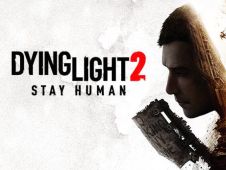 Dying Light 2: Stay Human Dying Light 2: Stay Human $59.99 Pre-order Network N earns affiliate commission from qualifying sales.
Dying Light 2: Stay Human Dying Light 2: Stay Human $59.99 Pre-order Network N earns affiliate commission from qualifying sales.
That’s the most game-breaking bug that I’ve run across, though it’s certainly not the only one. Unlocking safe zones, which are little spots protected from zombies by UV lights, is a primary activity in the open world, but after I turn on a generator for one of them, the lights don’t come on, leaving me with an unobtainable safe spot – and worse, an item I can’t mark off my checklist. You’re supposed to be able to use binoculars to find activities throughout the world, but it’s often a hunt to find the exact pixel you need to look at for a map marker to activate.
More frustrating still, every time I clear a manual waypoint marker from my map, a mysterious new one appears in a random location. Sometimes the button for survivor vision, which highlights nearby items and enemies, stops working for five or ten seconds at a time. Climbing objects, particularly indoors, occasionally send me shooting into the air and clipping into places I was definitely not supposed to reach. And for the final few hours of my playthrough, Aiden’s character model sits in a perpetual T-pose in the inventory screen. Techland promises a launch patch to address some technical issues in the review build, but the devs haven’t detailed what specifically is coming in that patch.
I understand that’s a lot of nitpicking, and none of those issues are large enough on their own to tear down the quality of Dying Light 2’s parkour or basic combat. But it’s the additive quality of all these little problems building up and growing more and more exasperating over the course of the game that drags it all down.
The story missions usually do what the side content can’t, providing more varied encounters and arenas in which you can flex your parkour abilities, stealthy movement, and weapon loadouts. Aside from some mediocre boss battles, the main missions largely fulfil the promise that the mechanics set forth. Some areas still get tiresome by the end, but there are enough thrilling chase sequences and explosive moments to make the story missions fun throughout, and occasionally even exhilarating.
Unfortunately, the narrative itself feels pretty rote. The original Dying Light is not particularly well-remembered for its narrative, but at least it had the good sense to limit its narrative to small cutscenes separating the major missions. In the sequel, everyone has so much to say, and they’re willing to provide you with way more lore than you could ever possibly want thanks to Mass Effect-style dialogue wheels.
I found myself engrossed in some of the plot beats, and there are likeable characters who are brought to life by strong performances from the voice cast, who elevate some really stilted dialogue. But the turns are ultimately predictable, and the characters fall into broad archetypes that range from familiar to laughable. On the latter point, Dying Light 2 is over reliant on child characters for its big emotional beats, which is ill-considered as it seems every child here is voiced by an adult actor.
A simple, predictable story could still be appealing if the game’s promise of choice and consequences ever felt like it paid off. In some cases, you do see characters you liked and supported take the lead in climatic story moments, and key missions play out a bit differently depending on who you side with. But these sorts of moments are isolated and inconsistent in the wider narrative.
I wanted to hate the Peacekeepers in a way Dying Light 2 was clearly not prepared for. The early stages of the story are framed as a conflict between the Peacekeepers – a militarised, authoritarian police force – and the Survivors, who are a loosely organised group of criminals, farmers, and everything in between. At every possible turn, I sided with Survivors over Peacekeepers. Sometimes I even got to fight the law. But again and again, the game kept railroading me back into story missions in which I teamed up with Peacekeepers. That would be fine if these alliances were in any way uneasy, but somehow, despite the fact that I took every opportunity I could to betray them and undermine their operations, Aiden and the Peacekeepers would reunite, constantly showering each other with mutual admiration and praise.
In theory, the Survivor versus Peacemaker conflict should affect the shape of the world, since each region of the map has a power or water facility that you can give to one side or the other to cement their control in that area. But there’s no dynamism to these choices – you get a few additional side quests with the faction you choose, and you move further along an upgrade tree that places bonus items in the open world.
You’ll find more guns and traps in areas controlled by Peacekeepers, while Survivor-controlled areas get renovations that aid movement, like jump pads and ziplines. Even when you hand complete control of the city’s vital infrastructure over to the Survivors, the most you’ll get from a Peacekeeper leader in the main story is a solitary line of dialogue that references your decisions.
The finale feels more like a last-minute attempt to fulfil the promises of a specific 2019 gameplay demonstration than an effort to play out the consequences of every choice you’ve made. There’s only a single save slot per playthrough, so I can’t go back to check what might’ve played out under different circumstances – at least, not without running through the entire story again – but the ending I got felt barely reactive to the decisions I’d made over the course of the whole campaign.
I spent around 30 hours with Dying Light 2, and I’d say I liked about ten of them. Ten more I tolerated, and the last ten saw my patience for its flaws wearing perilously thin; godspeed to any of you who go for that full 500-hour completionist run. The most frustrating part is that I love the freedom of running around the world and the crunchiness of the fighting when the battles are more varied. There are good parts to Dying Light 2, but they’re the same elements that made the first game such a success.
 Dying Light 2: Stay Human Dying Light 2: Stay Human $59.99 Pre-order Network N earns affiliate commission from qualifying sales.
Dying Light 2: Stay Human Dying Light 2: Stay Human $59.99 Pre-order Network N earns affiliate commission from qualifying sales.
